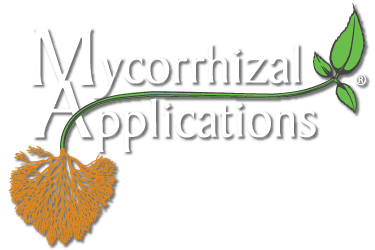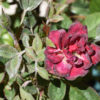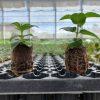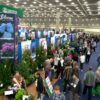
Over my career with Mycorrhizal Applications, one of the more frequently asked questions I get asked is how to best use mycorrhizae with hemp. This is a great question, and as a matter of fact, the answer can be quite simple. Hemp is not special in how it should be treated with mycorrhizae compared with other plants, but the unique production cost structure of hemp cultivation does clearly drive a positive return on investment. This means that hemp growers have a lot to gain from the utilization of MycoApply technology.
Is Hemp Mycorrhizal?
Let’s start by getting a key frequently-asked-question out of the way. Hemp is mycorrhizal, and in fact, it is endomycorrhizal (also known as Arbuscular Mycorrhizal Fungi or AMF). Hemp growers do not need to purchase an Endo/Ectomycorrhizal blend to grow hemp (although using a blend with ectomycorrhizae will not have any detrimental effect on the hemp crop).
Inoculation Timing
Similar to other plants, hemp should be treated during propagation. We suggest you apply MycoApply Endo mycorrhizae during propagation for three reasons: First, the cost of application is the lowest since you only apply the mycorrhizae to the seeded plug or clonal liner soil volume and not the final container. Second, the earlier you apply the mycorrhizae the sooner you start the symbiosis clock. The symbiosis between the plant and the mycorrhizae typically takes about four-weeks to establish. The sooner the plant is treated the sooner the plant can start to benefit. Visual benefits that the grower can see typically start to appear in an additional four weeks. And finally, the third reason is that when you transplant the liner/plug treated with mycorrhizae, the mycorrhizae treatment transfers with the liner/plug soil volume. And if that is not enough of a benefit, unlike most other production treatments, you do not need to reapply throughout the production cycle. One application is all you need. Mycorrhizae can be applied during propagation either through soil incorporation of your growing media before you plant, or via a drench of the plug or liner before or after planting.
Hemp + Mycorrhizae ROI
One thing that is unique about hemp compared with bedding plant production is the cost of genetics. Feminized seed or vegetative clones have a cost structure more similar to non-generic nursery stock. The cost of potential loss can be substantial. The desire to reduce plant loss leads us to one of the most important benefits of mycorrhizae use, the reduction of transplant loss and transplant shock. It is important to remember that this benefit can only happen if the mycorrhizae are applied during propagation and the symbiosis between the plant and the mycorrhizae happens before the plant is transplanted. Transplant loss is a simple term to understand. The goal of all growers is to reduce and ultimately eliminate all plant loss during transplant. Transplant shock on the other hand is a catch-all term referring to the number of stresses associated when a plant is transplanted from one soil environment to another soil environment. The level of transplant shock is usually defined by the length of time it takes the plant to resume growing at a rate similar to or greater than it was growing before it was transplanted. Transplant shock can also ultimately lead to transplant loss.
The reduction of transplant shock gives the grower a more uniform hemp crop in the field that can more fully take advantage of the vegetative growth period before the flowering stage is initiated.
How do Mycorrhizae Benefit Hemp Plants?
It is important to understand that the primary feature of mycorrhizae use with hemp is they work to expand the root absorptive area of the hemp plants. The increased root absorptive area of mycorrhizae-treated hemp plants allows the hemp plant to take up water more efficiently and absorb nutrients more effectively. Additionally, a greater amount of the applied nutrients is made available for use by the hemp plant. Mycorrhizae are also capable of unlocking non-soluble nutrients found within the soil and making them available to the plant. When nutrients are in excess they are stored by the mycorrhizae and made available for future use by the plant. Water is absorbed by the mycorrhizae hyphae and transported to the plant. When water is in excess, the hyphae become a repository for future water needs.
Mycorrhizae also have the ability to insulate the plant from salinity, both water and soil originating, and heavy metals. If mycorrhizae come across either of these situations, they absorb the salt or heavy metal and store it away so it can not cause harm the plant. Endomycorrhizae (AMF) are obligate symbiotes, meaning the mycorrhizae need the plant for long-term survival. A hemp plant associated with mycorrhizae will experience less stress, leading to improved plant health and ultimately a more successful hemp crop.
One additional variable that hemp production success is directly tied to is the quality of the field soil the plants are grown in. Fortunately, mycorrhizae can also positively influence soil structure. Soil structure can be defined as the arrangement of organic/mineral complexes (aggregates) and pore spaces. In 1996, scientists at the USDA, identified ‘glomalin’, a glycoprotein produced abundantly on hyphae of endomycorrhizal fungi. Glomalin acts as a ‘soil glue’ that binds micro-aggregates of soil into stable macro-aggregates. (You can think of glomalin in a similar way to the melted marshmallow holding together the Rice Krispies in a Rice Krispie treat.)
When writing this article, I thought it might be clever to title the article; “Mycorrhizae use makes Cents with Hemp”; but in reality, the title for this article should be “Mycorrhizae use in Hemp can Both Reduce Production Costs and Increase Profitability”.
If you have any questions about anything covered in this article, please contact your local Mycorrhizal Applications Representative or call 866-476-7800 or email us at inquiries@mycorrhizae.com.
Article by: Blair Busenbark
Mycorrhizal Applications – Sales and Commercial Marketing Manager
March 12, 2021






